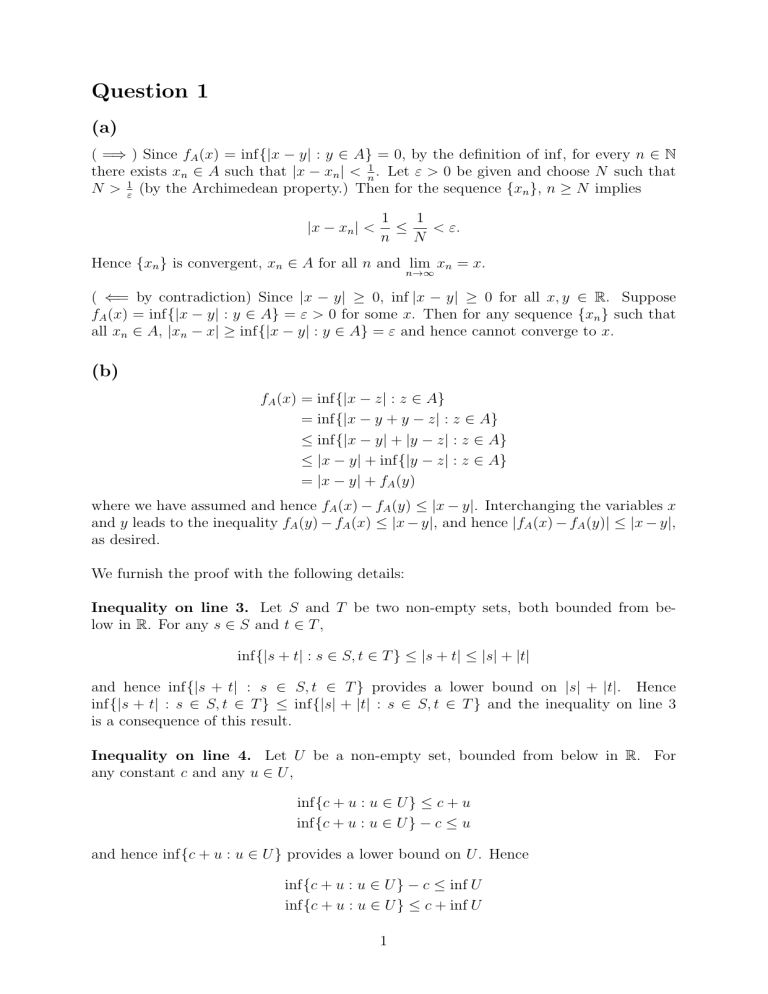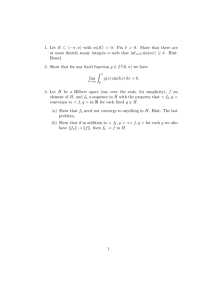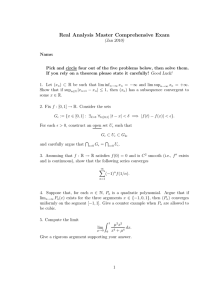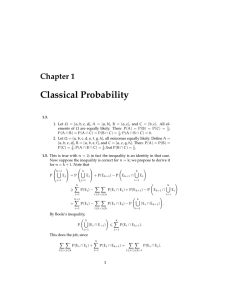
Question 1
(a)
( =⇒ ) Since fA (x) = inf{|x − y| : y ∈ A} = 0, by the definition of inf, for every n ∈ N
there exists xn ∈ A such that |x − xn | < n1 . Let ε > 0 be given and choose N such that
N > 1ε (by the Archimedean property.) Then for the sequence {xn }, n ≥ N implies
|x − xn | <
1
1
≤
< ε.
n
N
Hence {xn } is convergent, xn ∈ A for all n and lim xn = x.
n→∞
( ⇐= by contradiction) Since |x − y| ≥ 0, inf |x − y| ≥ 0 for all x, y ∈ R. Suppose
fA (x) = inf{|x − y| : y ∈ A} = ε > 0 for some x. Then for any sequence {xn } such that
all xn ∈ A, |xn − x| ≥ inf{|x − y| : y ∈ A} = ε and hence cannot converge to x.
(b)
fA (x) = inf{|x − z| : z ∈ A}
= inf{|x − y + y − z| : z ∈ A}
≤ inf{|x − y| + |y − z| : z ∈ A}
≤ |x − y| + inf{|y − z| : z ∈ A}
= |x − y| + fA (y)
where we have assumed and hence fA (x) − fA (y) ≤ |x − y|. Interchanging the variables x
and y leads to the inequality fA (y) − fA (x) ≤ |x − y|, and hence |fA (x) − fA (y)| ≤ |x − y|,
as desired.
We furnish the proof with the following details:
Inequality on line 3. Let S and T be two non-empty sets, both bounded from below in R. For any s ∈ S and t ∈ T ,
inf{|s + t| : s ∈ S, t ∈ T } ≤ |s + t| ≤ |s| + |t|
and hence inf{|s + t| : s ∈ S, t ∈ T } provides a lower bound on |s| + |t|. Hence
inf{|s + t| : s ∈ S, t ∈ T } ≤ inf{|s| + |t| : s ∈ S, t ∈ T } and the inequality on line 3
is a consequence of this result.
Inequality on line 4. Let U be a non-empty set, bounded from below in R. For
any constant c and any u ∈ U ,
inf{c + u : u ∈ U } ≤ c + u
inf{c + u : u ∈ U } − c ≤ u
and hence inf{c + u : u ∈ U } provides a lower bound on U . Hence
inf{c + u : u ∈ U } − c ≤ inf U
inf{c + u : u ∈ U } ≤ c + inf U
1
and the inequality on line 4 is a consequence of this result.
Now, let ε > 0 be given and choose δ = ε. Then
|fA (x) − fA (y)| ≤ |x − y| < δ = ε.
Hence fA (x) is uniformly continuous on R.
(c)
(i)
Since
• fA (x) is continuous,
• fA (x) + fB (x) is continuous and
• fA (x) + fB (x) ̸= 0 ∀x ∈ R,
fA (x)
is continuous on R.
fA (x) + fB (x)
Question 2
(a)
(i)
1
α
xn+1 =
xn +
2
xn
√
√
1
α
=
xn − 2 α +
+ α
2
xn
√ 2
√
xn
α
=
1−
+ α.
2
xn
√ 2
√
xn
α
Since xn > α > 0, we have that
> 0 and 1 −
> 0; and so
2
xn
√ 2
√
√
xn
α
xn+1 =
1−
+ α > α.
2
xn
√
√
This result combined with x1 > α together imply that xn > α for all n ∈ N, by the
Principle of Mathematical Induction (PMI).
(ii)
We show that {xn } is a decreasing sequence. Firstly,
√
1 √
α
5√
2 α+ √
=
α < 2 α = x1 ,
x2 =
2
4
2 α
2
√
where the inequality is satisfied since α > 0. Now assume xk−1 − xk > 0 for some k > 1,
then
α
α
1
xk−1 − xk +
−
xk − xk+1 =
2
xk−1 xk
1
α(xk − xk−1 )
=
xk−1 − xk +
.
2
xk−1 xk
√
√
α
α
Since xn > α for all n, we have that 0 <
< 1, and in particular 0 <
=
xn
xk−1 xk
√ √
α α
< 1. Then
xk−1 xk
α(xk − xk−1 )
1
xk−1 − xk +
xk − xk+1 =
2
xk−1 xk
1
> (xk−1 − xk + xk − xk−1 ) = 0,
2
where the inequality is satisfied under the assumption that xk − xk−1 < 0. Hence this
result together with x2 − x1 < 0 imply that {xn } is a decreasing sequence (by PMI).
√
Since {xn } is decreasing and bounded from below by α, it converges by the Monotone Convergence Theorem to a number, say x. Letting n → ∞ on both sides of the
recursion relation,
α
1
x+
x=
2
x
2
x =α
√
x= α
since the negative root contradicts our previous assumptions.
(b)
(i)
an+1
2 + 2/n
2
2 · 4 · 6 · . . . · (2n)
2n + 2
. Then
=
=
→ . By the Ratio
1 · 4 · 7 · . . . · (3n + 1)
an
3n + 4
3 + 4/n
3
n+1
∞
P (−1) 2 · 4 · 6 · . . . · (2n)
is absolutely convergent.
Test,
1 · 4 · 7 · . . . · (3n + 1)
n=1
Let an =
(ii)
√
√
n+1− n = √
1
1
1
√ ≥ √
√ = √
√ . By the Comparn+1+ n
2n + n
( 2 + 1) n
∞ √
P
√
1
ison Test with the 12 -series,
( n + 1 − n) diverges. However, an = √
√ >
n+1+ n
n=1
1
1
1
√
√
= an+1 and lim an = lim √
=
√ = lim √ p
n→∞
n→∞
n→∞
n+2+ n+1
n+1+ n
n( 1 + 1/n + 1)
1
1
p
lim √ ·
= 0 · 12 = 0. Furthermore all an > 0. Hence by the Altern→∞
n lim 1 + 1/n + 1
n→∞
∞
√
P
√
nating Series Test,
(−1)n+1 ( n + 1 − n) is conditionally convergent.
Let an =
n=1
3
Question 3
(a)
Consider the closed interval [0, m]. Then
sin(nx) + x
n+x
1+x
≤
n+x
1+m
→ 0.
≤
n
|fn (x)| =
Hence {fn (x)} converges uniformly to 0 on [0, m], and converges pointwise to 0 on [0, ∞)
since there is a closed interval [0, m] containing any M > 0.
Now consider the closed interval [0, ∞). Let ε = 41 and define the sequence {xn }∞
n=2 =
n ∈ [0, ∞). Then for all n ≥ 2 we have
sin(n2 ) + n
2n
n−1
≥
2n
1
1
= −
2 2n
1 1
1
≥ − = = ε.
2 4
4
|fn (xn ) − 0| =
We have shown that there exists a sequence {xn } with all xn ∈ [0, ∞) such that for n ≥ 2,
|fn (xn ) − 0| ≥ ε. So, {fn (x)} does not converge uniformly on [0, ∞).
(b)
By the Archimedean property, for any positive real number v satisfying 0 < v < 1, there
exists N ∈ N such that N > v1 . Hence, for all n ≥ N , gn (v) = 1 since n1 ≤ N1 < v < 1.
Thus gn (x) = 1 on [v, 1] for all n ≥ N and hence {gn (x)} converges uniformly to 1 on
[v, 1], and converges pointwise to 1 on (0, 1] since for any w such that 0 < w < 1 there is
a closed interval [ w2 , 1] that contains it.
1
However, by choosing ε = 1 and defining the sequence {xn } = n+1
, |gn (xn )−1| = |0−1| =
1 = ε. Hence there exists a sequence {xn } with all xn ∈ (0, 1] and |gn (xn ) − 1| ≥ ε; and
so {gn (x)} is not uniformly convergent on [0, 1].
Question 4
(a)
Note that |nk (x · ln(x + 1))2n | ≤ nk (1 · ln 2)2n = nk (ln 2)2n for all x ∈ [0, 1]. By the Ratio
Test,
k
(n + 1)k (ln 2)2n+1
1
= 1+
ln 2 → 1 · ln 2 = ln 2 < 1.
nk (ln 2)2n
n
4
Hence
∞
P
∞
P
nk (ln 2)2n converges and
n=1
nk (x · ln(x + 1))2n converges uniformly over [0, 1]
n=1
by the Weierstrass M -test.
(b)
First, we show for a fixed x ∈ [v, π − v] that the sequence of numbers {an } = 1 − e−x/n is
decreasing.
x x
− 1 − exp −
an − an+1 = 1 − exp −
n
n+1
x
x
= exp −
− exp −
n+1
n
x
x
−x/n
exp
=e
−
−1
n n+1
x
−x/n
−1
=e
exp
n(n + 1)
x
x
−x/n
≥e
1+
− 1 = e−x/n ·
≥ 0,
n(n + 1)
n(n + 1)
where the inequalities are satisfied because e−x/n > 0 and
x
n(n+1)
≥ 0 over [v, π − v].
Next, we show that the sequence of functions {fn (x)} = 1 − e−x/n converges uniformly to
0 over [v, π − v]. For all x ∈ [v, π − v],
|fn (x)| = 1 − e−x/n
≤ 1 − e−π/n
π π
= → 0.
≤1− 1−
n
n
n
P
Finally, we show that the partial sums sn =
sin(kx) are uniformly bounded over
k=1
[v, π − v] for all n ∈ N. For all x ∈ [v, π − v],
sin(nx + 1) sin(nx/2)
sin(x/2)
1
1
≤
≤
.
| sin(x/2)|
sin(v/2)
|sn | =
By the above results, the series of functions
∞
P
(1 − e−x/n ) sin(nx) satisfies the conditions
n=1
of Dirichlet’s Test for series of functions and hence converges uniformly on the closed
interval [v, π − v]. It follows that it also converges pointwise on [v, π − v].
5
(c)
By the Ratio Test,
an+1
(n + 1)3 ((n + 1)!)3 (3n)!
=
· 3
an
(3n + 3)!
n (n!)3
3
(n + 1)3
1
= 1+
n (3n + 3)(3n + 2)(3n + 1)
(1 + n1 )6
16
1
=
→
= .
3
2
1
3·3·3
27
(3 + n )(3 + n )(3 + n )
Hence the radius of convergence is 27.
Question 5
(a)
Consider the sequence of partial sums:
sn =
n k
X
x
k=1
1
xk+1
−
k
k+1
x
x2 x2 x3
xn+1
−
+
−
+ ··· −
1
2
2
3
n+1
n+1
x
.
=x−
n+1
=
We consider two cases.
Case 1. |x| ≤ 1. For |x| ≤ 1, x −
lim
n→∞
xn+1
xn+1
≤ sn ≤ x +
and
n+1
n+1
xn+1
1
= lim
lim |xn+1 | ≤ 0 · 1 = 0.
n→∞ n + 1 n→∞
n+1
Hence by the Squeeze Theorem, lim sn exists and equals x.
n→∞
Case 2. |x| > 1. Since |x| > 1, there exists N ∈ N such that |x| > 1 +
6
1
N
(by the
Archimedean property.) Then for all n ≥ N we have
|sn | = x −
≥
>
=
=
>
=
xn+1
n+1
xn+1
− |x|
n+1
(1 + N1 )n+1
− |x|
n+1
(1 + N1 )n+1 N + 1 N + 2
n
·
·
...
− |x|
N +1
N +2 N +3
n+1
(1 + N1 )N +1 1 + N1
1 + N1
1 + N1
·
·
.
.
.
− |x|
N +1
1 + N1+1 1 + N1+2
1 + n1
!n−N
(1 + N1 )N +1
1 + N1
− |x|
N +1
1 + N1+1
!n
(1 + N1+1 )N
1 + N1
− |x|,
N
1 + N1+1
1+1/N
where the first term forms a geometric progression with common ratio 1+1/(N
> 1.
+1)
This term diverges and by the Comparison Test, |sn | diverges. Hence sn diverges (by the
contrapositive of: sn converges =⇒ |sn | converges.)
n
∞
P
x
xn+1
Combining these two results gives us that the series of functions
−
conn
n+1
n=1
verges pointwise over D = [−1, 1].
It is not true, however, that
"∞ #
∞
X
xn+1
d
d
d xn
xn+1
d X xn
−
=
lim sn = lim
sn =
−
n→∞ dx
dx n=1 n
n+1
dx n→∞
dx
n
n+1
n=1
for all x ∈ D. From the LHS,
d
d
lim sn =
(x) = 1
n→∞
dx
dx
for all x ∈ D. From the RHS,
d
sn = lim (1 − xn )
n→∞ dx
n→∞
lim
which is 0 for x = 1 and does not exist for x = −1.
(b)
2x + nx3
−x
1 + nx2
x
=
1 + nx2
|fn (x) − x| =
7
1
1
which has maxima at x = ± √ . So for all x ∈ R, |fn (x) − x| ≤ √ → 0. Hence,
n
2 n
{fn (x)} converges uniformly on R to f (x) = x. However,
(1 + nx2 )(2 + 3nx2 ) − (2nx)(2x + nx3 )
(1 + nx2 )2
(1)(2)
=2
fn′ (0) =
12
fn′ (x) =
for all n. Hence lim
n→∞
fn′ (0)
′
′
= 2 ̸= 1 = f (0), and it is not true that f (x) = lim
n→∞
d
(fn (x))
dx
for all x ∈ R.
(c)
Let ε > 0 be given. Since {gn (x)} converges pointwise on [0, 1], there exists N1 , N2
such that n ≥ N1 implies |gn (0) − K| < ε and n ≥ N2 implies |gn (1) − K| < ε. Let
N = max{N1 , N2 }. Then for all n ≥ N , we have that gn (0) > K − ε and gn (1) < K + ε,
and
K − ε < gn (0) ≤ gn (x) ≤ gn (1) < K + ε
for all x ∈ [0, 1], under the assumption that gn (x) is monotone increasing on [0, 1]. Hence
|gn (x) − K| < ε for all n ≥ N and x ∈ [0, 1], i.e., the convergence of {gn (x)} is uniform
on [0, 1].
8






